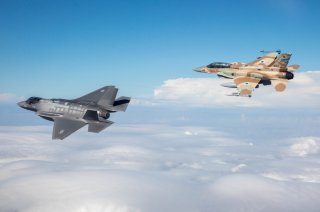Iran vs. Israel: Who Wins a (Nuclear?) War?
What would a hot war look like?
Here's What You Need to Remember: Eventually, the stockpiles of missiles and rockets held by Iranian proxies would dwindle, as would the enthusiasm of those proxies for enduring Israeli punishment. For their part, the Israelis could only inflict so much damage on Iran before exhausting the goodwill of the Gulf monarchies. Of course, much would depend on the attitude of the United States.
Worries over war in the Middle East have largely shifted away from the tense relationship between Iran and Israel. Turkey’s ongoing conflict with the Kurds and Iran’s own jousting with Saudi Arabia have taken center stage, although Israel’s concern over growing Iranian influence has not abated. In such an unpredictable security environment, however, war remains a possibility. How might a hot war between Israel and Iran play out?
Causes
Contrary to popular belief, wars rarely start by accident. While Iran and Israel have poked each other regularly over the last three years, both countries have determined that open war is not in their interests. That determination would have to change in at least one of the countries. Tehran might decide to undertake a diversionary war to distract from popular uprisings and economic difficulties at home, or might determine that a short war would win it enough political credit in the region to run the risk of accepting significant damage. Israel, on the other hand, might determine that a quick, devastating war could delegitimize and destabilize the Islamic Republic and reduce its influence across the region. From the Israeli point of view, a barrage of Iranian supplied rocket and missile attacks would prove inconvenient, but probably not an existential danger.
Balance of Capabilities
Israel has substantial advantages over Iran at every type of conventional weaponry, except possibly conventionally armed ballistic missiles. With inflight refueling, the Israeli Air Force can strike targets across Iran, although it might struggle to retain overflight rights from neighboring countries in the case of an extended war. The Iranian Air Force would be wise to absent itself from the battlefield, and because of the distance of its eastern bases from Israel could probably avoid destruction. Israel also has substantial advantages at sea, and can overmatch (if not necessarily destroy) Iran’s proxies on land.
For its part, Iran has already deployed substantial military assets into both Syria and Iraq. Sometimes operated by proxies, and sometimes by Iranian personnel, missile and rocket batteries can strike targets across Israel, and perhaps hope to (temporarily) overwhelm Israel’s network of missile defense systems. Iran has some ballistic missiles that it can fire from its own territory, and Iran’s daring UAV attack against Saudi oil facilities might provide a model for how it would fight against Israel, although the tyranny of distance would complicate planning.
Proxies
The brunt of Israeli attacks would fall on Iran’s proxies in Syria, Lebanon, Gaza and Iraq. In Lebanon, Hezbollah has prepared extensively for conflict, honing its skills during fighting in Syria and increasing the size of its rocket and missile stocks. Israeli airstrikes (and potentially Israeli ground incursions) would focus on rapidly reducing the number of advanced missile and rocket launchers. Similar strikes would take place in Gaza. In Syria, the Israelis would concentrate on the transportation infrastructure the Iranians use to transfer missiles to their proxies. Israel would also likely strike Iraq, potentially destabilizing that country’s government; the Iranians would undoubtedly also put considerable pressure on the Baghdad government. Indeed, this war is already happening at one level. In November, in retaliation for rocket attacks launched from Syrian territory, Israeli warplanes destroyed an Iranian Revolutionary Guard headquarters in Syria. This came as part of a broader Israeli air campaign that has hit dozens of targets in Syria and Iraq.
Direct Attacks
The Israeli Air Force could certainly inflict significant damage on targets inside Iran with several large-scale strikes. An Israeli attack could target Iran’s declared nuclear facilities, as well as its ballistic missile design and production facilities, although it’s not clear how much lasting damage the Israelis could inflict. Israel could also strike Iran’s oil infrastructure, although sanctions have already curtailed much of the productivity of the oil sector.
However, attacking Iran requires overflying several unfriendly countries, and it is unlikely that even Saudi Arabia would grant extended overflight rights for an Israeli campaign. Iraq, highly likely to be the target of some Israeli attacks, would also resist granting overflight rights. Israel could of course simply fly over countries without permission, but this would become politically awkward over time, especially for the Saudis.
Price of War
How long would the war last? Eventually, the stockpiles of missiles and rockets held by Iranian proxies would dwindle, as would the enthusiasm of those proxies for enduring Israeli punishment. For their part, the Israelis could only inflict so much damage on Iran before exhausting the goodwill of the Gulf monarchies. Of course, much would depend on the attitude of the United States. Although President Donald Trump has been notably reluctant to strike Iran despite having pretexts to do so, he might be more inclined to intervene on behalf of Israel. Most likely, however, the cost of the war would be borne by those who had the least input into how and why it was waged; the innocent civilians of the countries between Israel and Iran.
Robert Farley, a frequent contributor to the National Interest, is author of The Battleship Book. He serves as a Senior Lecturer at the Patterson School of Diplomacy and International Commerce at the University of Kentucky. His work includes military doctrine, national security, and maritime affairs. He blogs at Lawyers, Guns and Money and Information Dissemination and The Diplomat.
This first appeared in 2019 and is being reposted due to reader interest.
Image: Wikipedia.

